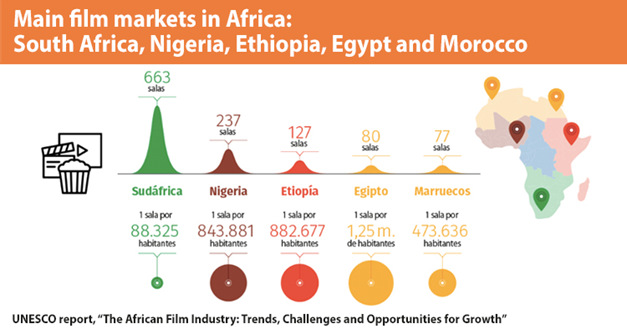The first cinema screenings in Africa date back to 1905 in Egypt and the 1920s in sub-Saharan Africa. These screenings occurred in urban theaters and through traveling exhibitions in rural areas. In terms of film production, Zohra (1922), a Tunisian production, is widely recognized as the first film shot by an African. It was soon followed by La Fille de Carthage (1924), Leila (1926), and Zainab (1926).
Egyptian and Tunisian cinemas rank among the oldest in the world. Egyptian cinema, in particular, emerged as a thriving industry. Pioneers Auguste and Louis Lumière showcased their films in Alexandria, Cairo, Tunis, Susa, and Hammam-Lif (Tunisia) in 1896, with additional screenings in Libya. Albert Samama Chikly, often hailed as the first indigenous African filmmaker, screened his short documentaries at the Tunis Casino as early as December 1905. Collaborating with his daughter Haydée Tamzali, Chikly produced significant historical works such as The Daughter of Carthage (1924). In 1927, Egypt released Leila (1927), the first feature film directed by Aziza Amir, who is celebrated as the godmother of African cinema.
In 1935, Cairo’s Misr Studio began producing comedies, musicals, and critically acclaimed films like Kamal Selim’s The Will (1939). Egyptian cinema reached its golden age during the 1940s–1960s. Youssef Chahine’s seminal work Gare Centrale (1958) laid the foundation for Arab cinema, cementing Egypt’s influence on the region’s cinematic landscape.
Despite these pioneering beginnings, the reluctance of colonial governments and a lack of resources meant that most of the continent only began to see significant local achievements from the 1970s onward. To this day, African cinema remains largely financed by Western funds, and its development has remained modest.
Since the 1990s, film production has declined, and movie theaters have closed, leaving some countries without a single cinema. The Pan-African Film and Television Festival of Ouagadougou (FESPACO)—one of Africa’s largest film festivals, whose 24th edition was held in 2015—continues to strive to preserve and promote African cinema.
SVOD subscribers in Africa by platform in 2029 (Source: Digital TV Research)
However, there is the notable exception of Nollywood. Nigeria produces nearly two thousand films per year, making it the world’s second-largest film producer by volume, behind India’s Bollywood and ahead of the United States. These films, primarily low-budget productions released directly on VCD, are more than half in local languages. Their artistic quality is often considered “questionable,” and their technical standards are too low for television broadcast.
Nonetheless, African cinema has demonstrated its ability to shine on the international stage—just as in other artistic fields—when “the quality, genre, and themes of the films take precedence over geographical or political criteria,” as evidenced by its presence at international festivals such as Sundance.
For more information :
- https://fr.wikipedia.org/wiki/Portail:Afrique
- https://en.wikipedia.org/wiki/Africa
- https://africacenter.org/
- https://journals.openedition.org/etudesafricaines/
- https://etudes-africaines.cnrs.fr/
- https://journals.openedition.org/etudesafricaines/
- https://www.afdb.org/fr/documents-publications/economic-perspectives-en-afrique-2024


